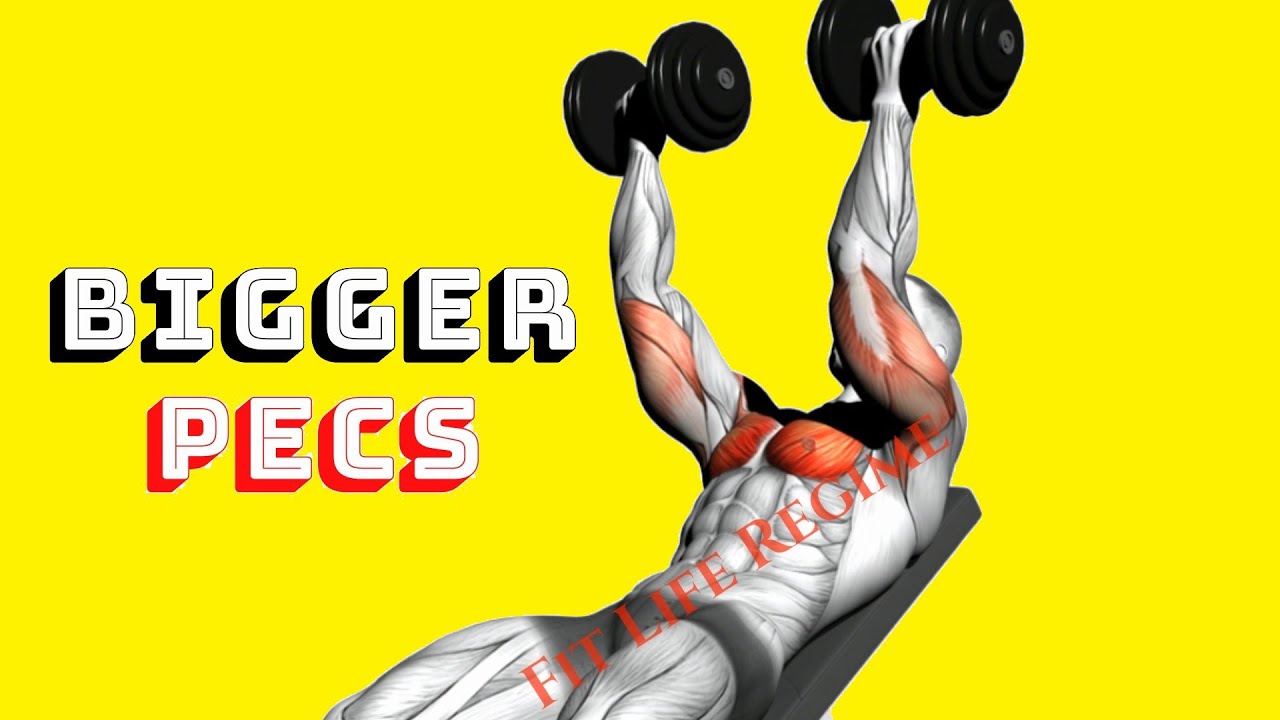If you want to build greater thickness and strength in your upper pecs, you must add an incline dumbbell bench press to your training regime.
The incline dumbbell bench press, aka dumbbell incline chest press, is an upper body workout that engages the upper pec muscles, the triceps, and the anterior deltoid muscles of the shoulders.
It is also easy to learn and progressively overload, so both beginners and advanced can effectively add it to their chest workout routine.
You will learn how to correctly perform an incline dumbbell bench press based on biomechanics, the best angle, and its variations.
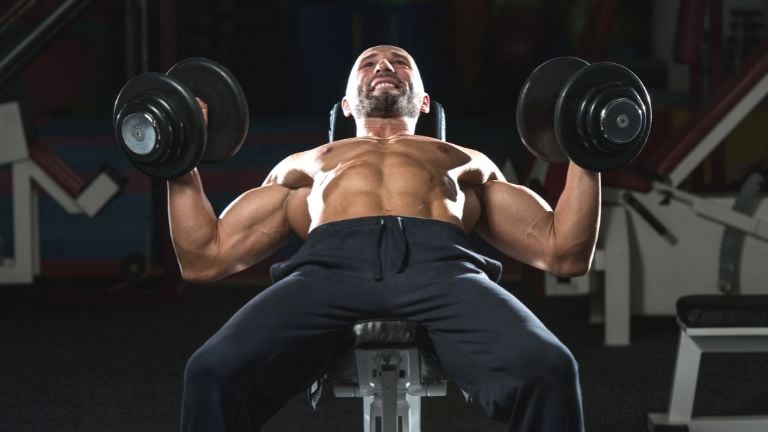
- Incline Dumbbell Bench Press Angle
- Note
- Incline Dumbbell Press Muscles Worked
- How To Do Incline Dumbbell Bench Press
- Proper Form and Technquies
- Best Variations of Incline Dumbbell Chest Press
- 1. Single Arm Incline Dumbbell Press
- 2. Reverse Grip Incline Dumbbell Bench Press
- 3. Incline Dumbbell Squeeze Press
- FAQs
- Incline Dumbbell Press Vs. Flat Dumbbell Press
- Is the incline bench 30 or 45 degrees?
- What muscles does incline bench press work?
- How does incline bench press help you?
- References
- 7 Best Incline Chest Press Variations
Incline Dumbbell Bench Press Angle
The incline bench press is one of the best upper chest exercises, but there’s one major problem: the front deltoid likes to dominate the movement, preventing us from getting the maximum benefit.
The anterior deltoids and the upper chest are very close to each other, which means that if we don’t do the exercise correctly, one of the two can start dominating the other. When you do the incline bench press, it’s important to get the bench angle correct.
Research shows that the best way to work on the upper part of your chest is to do the incline bench press at a 30-degree angle.
Even though 30 degrees may seem like a small angle, it is the proper angle to train your upper pecs and minimize the effect on the anterior deltoid muscles.
If you set the incline bench press angle to 60 degrees, that people will use for an incline bench press, then you’re going to shift the focus from the upper chest to the anterior deltoid.
An upright position will maximize the attention that the front delts get because the arms will move in a straight line up against gravity in an overhead pressing motion.

Note
Keep the bench’s angle at 30 degrees for proper stimulation of the upper chest muscles. If you want to increase the angle further, please avoid going beyond 45 degrees, as this will shift the focus to the anterior deltoid.
Incline Dumbbell Press Muscles Worked
- Primarily Muscles Worked: Pectoralis major muscles (Upper Chest)
- Secondary muscles worked: Anterior deltoid, and Triceps brachii.
- Synergist muscles and stabilizer muscles: Rotator Cuff Muscles, Core Muscles (Rectus Abdominis, Obliques), Biceps brachii, and Serratus Anterior.
How To Do Incline Dumbbell Bench Press
- Adjust the bench to an incline position, typically between 30 to 45 degrees. We’re aiming for that sweet spot where you’ll really feel it in your upper chest.
- Now, grab your dumbbells and take a seat. Rest them on your thighs for a second.
- As you lay back, use your thighs to help lift the dumbbells to a position slightly wider than shoulder-width apart, at chest level.
- Your feet should be firmly planted on the ground, creating a stable foundation.
- Hold the dumbbells with a palms facing forward.
- Your elbows should be angled slightly towards your torso (about 45 degrees from your body).
- Inhale and lower the dumbbells slowly and controlled. Let your elbows drop until the dumbbells are roughly at chest level.
- Ensure the movement is controlled and the dumbbells don’t bounce off your chest.
- Press the dumbbells back up to the starting position as you exhale by contracting your chest muscles. Think about squeezing your chest at the top of the movement.
Proper Form and Technquies
- It is best to set the bench at about 30 degrees inclined. Do not go more upright as the stress shifts more to the shoulders rather than the chest area.
- Be sure to keep your elbows slightly bent. This helps maintain greater tension on the pectorals and protects the elbow joints.
- Keep your feet flat on the floor and don’t allow your lower body to move during the set.
- Ensure you maintain some tension in your abs and don’t allow your lower back to excessive arch.
- Don’t let the dumbbells clash against each other on every rep: bouncing them against each other can cause your shoulders to lose stability and cause injury.
- Keep a controlled motion and avoid jerky movements.
- Ultimately, your results will depend on your ability to adequately recover from your workouts. To allow sufficient recovery, it is recommended that you allow at least 36 to 48 hours of rest before training the same muscle groups again.
- Vary bench angles to hit different angles of the chest, but do not go beyond 45 degrees.
- Training volume refers to the total amount of work you perform during a workout, including the number of sets, reps, and weights used. Of course, the number of sets and reps will be determined based on your fitness journey, but here is a great starting point.
| Training Level | Weekly Sets | Reps (Per Set) | Recommended Weight | Goal |
|---|---|---|---|---|
| Beginners (≤1 year of training) | 12 weekly sets | 15-20+ reps | Moderate resistance | Muscle endurance |
| Intermediate (2-4 years of training) | 16 weekly sets | 6–10 reps | Heavy resistance | Muscle strength |
| Advanced (4+ years of training) | 20 weekly sets | 8–12 reps (3-4 sets) | Moderate to heavy resistance | Muscle hypertrophy (size growth) |
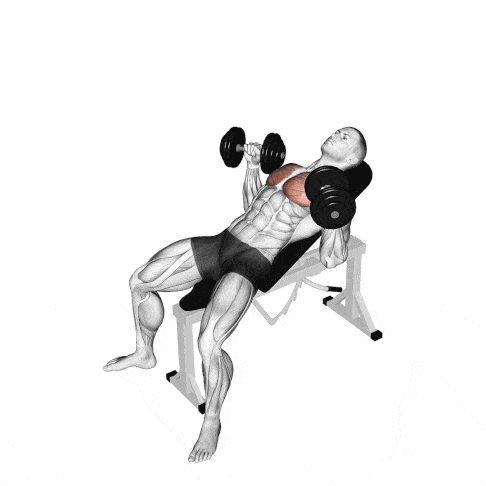
Best Variations of Incline Dumbbell Chest Press
The incline dumbbell bench press can be done differently to suit your fitness level.
- If you’re a beginner, try lowering the bench to a flat position or use lighter weights to make it easier.
- For a more advanced challenge, you can try variations like the single-arm incline press or reverse grip incline dumbbell bench press. You can also increase the bench incline and use heavier weights but always prioritize proper form.
1. Single Arm Incline Dumbbell Press
A single arm press allows unilateral training (one limb at a time) and forces each side of your chest to work independently. Trust me, it increases core stability and improves muscular imbalances.
The incline one-arm dumbbell bench press is great for developing unilateral upper-body strength and coordination.
It allows for greater joint safety and stabilization and allows the joints to move naturally within their range of motion.
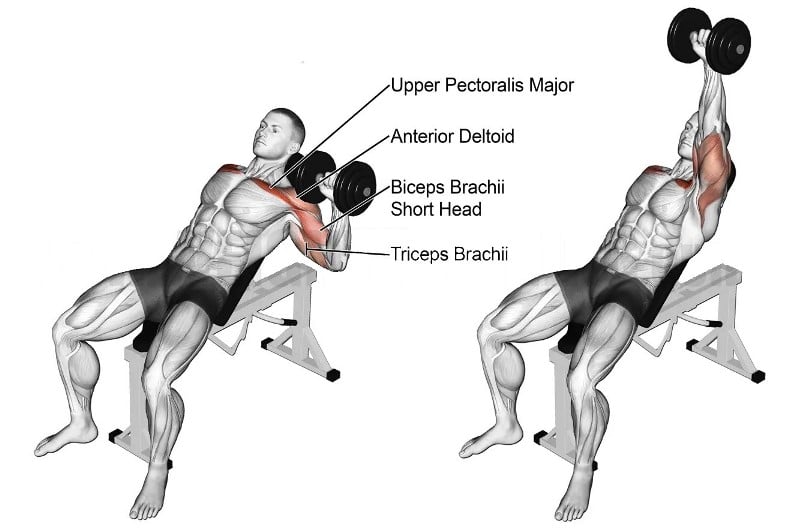
2. Reverse Grip Incline Dumbbell Bench Press
The reversed dumbbell press is an unconventional exercise compared to the standard dumbbell press; however, it provides greater stimulation to the upper chest and triceps.
If you’ve been dealing with any shoulder pain from regular bench presses, this might be your new best friend. The reverse grip takes some of the stress off your shoulder joint.
A group of Canadian scientists found that the muscle activity of the upper pecs in weight-trained subjects performing reverse-grip bench presses was more than 30% greater than when they did standard-grip bench press.
Oh, and don’t be surprised if you notice your forearms burning a bit. This grip really challenges your grip strength, so you’re toning those forearms without even trying.
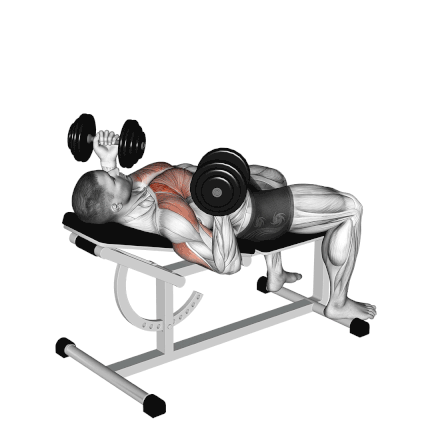
3. Incline Dumbbell Squeeze Press
The incline dumbbell squeeze press is one of the most effective chest pressing exercises which targets the Inner chest and upper chest.
Since it’s performed on an incline bench, the focus is on the upper pectorals (clavicular head), and the squeezing action works the inner portion of the chest muscles.
While your chest is doing most of the work, don’t forget your shoulder. The incline position engages your anterior delt to step up, contributing to overall shoulder strength.
During the squeeze press, the dumbbells are always in contact with each other, and you actively squeeze them inward (against each other) as hard as possible.

FAQs
Incline Dumbbell Press Vs. Flat Dumbbell Press
The main difference between the incline dumbbell chest press and the flat dumbbell press is that the incline dumbbell press emphasizes more the clavicular (upper) head of the pecs. At the same time, the flat dumbbell press emphasizes both head, the clavicular (upper) and sternocostal (lower) head.
If you want well-developed, proportionate pecs, then it makes sense to include a mix of incline and flat pressing in your workout routine.
Is the incline bench 30 or 45 degrees?
Research shows that the correct angle of the Incline Bench Press should be 30 degrees from flat to target the upper chest. So, it is best to set the bench at about 30 degrees inclined. It is important not to go too upright because then the stress will shift to the shoulders rather than the chest.
What muscles does incline bench press work?
The incline bench press is one of the best upper chest exercises, but you need to ensure that your front delts do not dominate the movement. To avoid this, be sure to use the correct bench angle and squeeze your shoulder blades during the movement.
How does incline bench press help you?
The incline bench press is one of the best upper chest exercises, but you must avoid allowing your front delts to dominate the movement.
References
- Influence of bench angle on upper extremity muscular activation during bench press exercise. Lauver, J. D., Cayot, T. E., & Scheuermann, B. W. (2015). European Journal of Sport Science, 16(3), 309-316. doi:10.1080/17461391.2015.1022605. URL: https://www.tandfonline.com/doi/full/10.1080/17461391.2015.1022605, accessed on 24.08.2020
- An Electromyography Analysis of 3 Muscles Surrounding the Shoulder Joint During the Performance of a Chest Press Exercise at Several Angles. Trebs, A. A., Brandenburg, J. P., & Pitney, W. A. (2010). Journal of Strength and Conditioning Research, 24(7), 1925-1930. doi:10.1519/jsc.0b013e3181ddfae7
7 Best Incline Chest Press Variations

Manish is a NASM-certified fitness and nutrition coach with over 10 years of experience in weight lifting and fat loss fitness coaching. He specializes in gym-based training and has a lot of knowledge about exercise, lifting technique, biomechanics, and more.
Through “Fit Life Regime,” he generously shares the insights he’s gained over a decade in the field. His goal is to equip others with the knowledge to start their own fitness journey.

